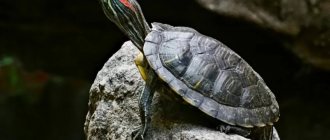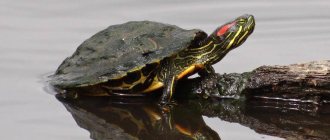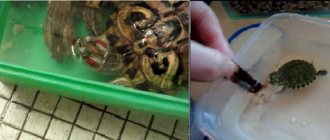Quickly navigate to the article
- 1 Causes of fungus
- 2 Signs of the onset of the disease
- 3 Treatments
- 4 Disease prevention 4.1 Other interesting articles
In many countries, many families keep freshwater reptiles; the red-eared slider has become the most popular in recent years. This is a green turtle with red ears on its head. “The most aquarium reptile” is not aggressive, but sometimes it bites painfully. Anyone who expresses a desire to have a little aquaterrarium owner should think carefully. After all, this is not a cat or a dog, this is a reptile that will need water to swim, and land where it can warm up under a lamp.
You need to know why your charming pet might get sick. Diseases are most often the consequences of poor living conditions, improper care and nutrition, and contact with sick animals. The article talks about the most common disease - fungus, how to recognize it, and how to treat your pet if an infection occurs.
White coating on the shell of a red-eared turtle
In many countries, many families keep freshwater reptiles; the red-eared slider has become the most popular in recent years.
This is a green turtle with red ears on its head. “The most aquarium reptile” is not aggressive, but sometimes it bites painfully. Anyone who expresses a desire to have a little aquaterrarium owner should think carefully. After all, this is not a cat or a dog, this is a reptile that will need water to swim, and land where it can warm up under a lamp. You need to know why your charming pet might get sick.
Diseases are most often the consequences of poor living conditions, improper care and nutrition, and contact with sick animals. The article talks about the most common disease - fungus, how to recognize it, and how to treat your pet if an infection occurs.
Eye infections
Diseases of the visual organs in red ear are most often diagnosed:
- Conjunctivitis can be caused by dirty water in the aquaterrarium, staphylococci and streptococci. It can also be observed against the background of rickets, pneumonia, and vitamin deficiency. The fact that a reptile has conjunctivitis is indicated by a number of symptoms: the eyes are red, pus is released from them, and the eyelids are swollen. The pet’s general well-being also suffers: it becomes lethargic, does not eat anything, and is indifferent to what is happening. The reptile constantly rubs its sore eyes with its front paws; in advanced cases, the eyes close completely. In case of illness, antibiotics are indicated.
- Panophthalmitis occurs when germs penetrate under the cornea of the eye. This disease causes clouding of the eye and damage to the lower eyelid. Antibiotic therapy is prescribed, and sometimes removal of the eye is required. What to do if this pathology develops should only be decided by a doctor.
Causes of fungus
The appearance of the disease, the first sign of which is a white coating on the animal’s shell, occurs at any age. The causative agent of the disease is a fungus of the genus Candida; there are others, such as pathogenic fungi.
Red-eared turtles are not susceptible to the disease very often in natural conditions; this mainly occurs when kept in captivity. The causes of shell disease are different:
- Treatment of reptiles with antibacterial agents, which results in a decrease in the effectiveness of the immune system.
- High humidity.
- There is no place for heating with an ultraviolet lamp.
- Non-compliance with diet.
Article on the topic: The rat is breathing heavily (opens its mouth, wheezes or grunts when breathing)
It is still difficult for inexperienced turtle owners to correctly answer the question of why the shell of a red-eared turtle turns white and to predict the occurrence of a fungal infection. Although, at the first appearance of a white coating, you can guess that this is already an infectious breeding ground.
Typically, the fungus can manifest itself in a humid environment when the water temperature in the aquaterrarium reaches +26 degrees. At this temperature, the animal prefers to stay in the water longer and has no desire to dry out on the island. The favorable period for the proliferation of fungal infections is molting. At this time, the turtle’s skin loses its antiviral resistance.
It is recommended to maintain the water temperature from 28 to 26 degrees; on the island it should be at 28-32 degrees. Then the turtle will move to land to dry and warm up under a lamp or in the gentle sun. In such conditions, the fungus is unlikely to bother the pupil.
A place for heating should be arranged taking into account the size of the animal. The larger it is, the larger the heating area should be. Only in this way will the turtle be able to willingly go onto land and spend enough time there.
People who have had a turtle for more than one year probably know that if you treat your pet with antibiotics for a long time, this process almost always ends with the appearance of fungus on the shell. You need to start preparing for such an outcome in advance. The reasons for the appearance of fungus include the following:
- The water in the terrarium is hard.
- Stressful situations.
- Errors in nutrition.
- Presence of fungus.
You should never add water taken from the tap to the terrarium. Animals can get sick from such negligence.
Detachment of horny plates: symptoms
In many aquatic reptiles, which includes the red-eared turtle, diseases (see photo in this article) can even affect the shell. Usually their horny scutes do not fall off, although this still happens during the growth period. With age, this process slows down significantly. When the plates begin to peel off again, it depends only on improper maintenance conditions.
The causes of horn delamination can be drying out, the presence of pathogenic fungus, blue-green algae, as well as a lack of vitamins A and B₂. It's okay if the shield falls off evenly, repeating the shape of the backing. But things are bad if:
● The plate has delaminated and cavities and small bubbles have formed in it. Such consequences are caused by various fungal infections. If there are brownish crusts or gray plaque on the inner surface of the desquamated shield or on top of the new horny plate, then in this case the pathogenic process can be excluded. The fact is that the fungus can live exclusively on dead tissue. The same effect will occur from the introduction of blue-green algae.
● The plate is hypertrophied (thickened) and begins to peel off from the middle somewhere in the deep layers. Most often, this problem can be eliminated by proper feeding and the introduction of appropriate vitamins.
● The horn peels off in the same places, forming soft areas in the form of light spots. Sometimes under the shield you can immediately detect the periosteum, on which drops of blood appear after wiping it with a bandage. This is a very serious problem - shell ulcer, which in English literature is referred to as USD. It has a bacterial etiology, where Beneckia hitinovora and Citrobacter freundi are quite often present.
Signs of the onset of the disease
Red-eared turtles are often susceptible to fungal diseases, especially in the spring, when their immunity is severely weakened. Sometimes the fungus is confused with molting. To avoid this and start treatment on time, you need to know the signs of the disease. The following symptoms indicate a fungal infection:
- The affected areas of the shell and skin are covered with white spots that can be removed.
- The skin begins to peel off, and rags hang on it.
Article on the topic: What to do if a chinchilla is constipated: symptoms, treatment, prevention
This is the stage at which urgent treatment is required. This way you can prevent serious consequences when the turtle’s body is already covered with many ulcers, which leads to blood poisoning.
External signs are not an accurate method of diagnosis, especially if it is not done by a professional. Only an experienced specialist can draw correct conclusions about the state of health when examining an animal. But additional research will be needed, after their results we can say whether the reptile has an infectious disease or not. After determining an accurate diagnosis, the necessary antifungal drugs are prescribed, which are very toxic and often lead to death.
Necrotizing stomatitis
Stomatitis is a lesion of the oral mucosa.
When the skin dies, stomatitis becomes necrotic. Externally, the disease manifests itself as follows: the turtle’s tongue becomes inflamed, mucus begins to flow from the mouth, later the gums become hyperemic, and the disease is difficult to bear. Doesn't eat anything. Stops eating food. It is rare that stomatitis comes alone; it usually causes many other diseases.
For treatment, the temperature should be increased by 6 degrees, bacterial preparations should be administered, and decamethoxin should be added inside. Purulent discharge must be removed from the mouth with a swab and tweezers.
Therapeutic measures
Treatment of your pet should be entrusted only to an experienced specialist who will accurately determine the disease by performing the necessary clinical tests and immediately prescribe suitable medications for the treatment of the fungus. If this is not possible, you need to quickly start treating yourself, without delaying this process for long.
Approximate instructions for treating fungus:
- Regardless of the type of fungus, the aquaterrarium, including all objects in it, is completely disinfected.
- If the sick individual is not alone in her home, she should be immediately removed for the duration of treatment, which lasts from two weeks to two months.
- Bring the water temperature to 30 degrees and add methylene blue to it. The water should turn slightly bluish. After this, place the sick reptile there, where it should remain all day. It is important to ensure normal heating on the site. Chamomile effectively fights the disease; it is good if you alternate a decoction of it with methylene blue.
- At night, it is recommended to place the turtle in a dry place and allow it to dry thoroughly.
- An effective therapeutic effect is provided by a tincture of oak bark, in a bath from which a sick turtle is placed for 1 hour. Treatment is continued until complete recovery. The water should have a tea tint.
- Daily irradiation of a sick animal with an ultraviolet lamp helps destroy the infection.
- Places with formed ulcers are treated with antifungal ointments: Nizoral, Triderm, Clotrimazole and others. Treat the skin overnight.
- Nutrition during the treatment period should be rich in vitamins and minerals.
Article on the topic: The red-eared turtle's eyes are swollen and do not open, she is blind and does not eat: what to do, how to treat at home?
In addition to the above recommendations, there are many other ways to treat fungal diseases, which your veterinarian can advise you on.
Pneumonia
As it turns out, pneumonia can develop not only in humans, but also in turtles. This happens when the reptile’s body becomes hypothermic. The disease is considered serious, and if the pet does not receive timely treatment, there is a risk of death.
Signs of the disease can be noticed within 24 hours after the onset of the inflammatory process. The reptile will be on land or swimming on the surface more often, as it will lose the ability to dive. Pneumonia is treated with medication or using traditional recipes. It is possible to achieve the greatest efficiency only with an integrated approach:
- Intramuscular injections (drugs "Baytril", "Amikacin") are required - consultation with a veterinarian is required, as it is important to determine the exact dosage. If the dose is determined incorrectly, the medicine will not only not help, but can also lead to the death of the turtle.
- Methods of traditional medicine - steam inhalations and warm baths with a decoction of chamomile flowers have a high effect. The reptile is first held over steam and then immersed in liquid for 25-30 minutes. The optimal temperature of the solution for the treatment of pneumonia should not be higher than 30°C.
Disease prevention
There is one true truth: it is better to prevent a disease than to treat it. Owners with considerable experience do just this and regularly carry out preventive measures, especially when the turtle has an acute respiratory infection and a disorder in its digestive organs. When the body is severely weakened, all energy goes to fight the above ailments.
Preventive measures are carried out with the animal once every few months; for this purpose, the terrarium is etched with methylene blue. Having carried out prevention, you then need to provide the animal with normal conditions: ideal cleanliness, recommended temperature conditions and diet. All three components will help raise a healthy pet.
The turtle should receive ultraviolet irradiation for half of the day; for this, an appropriate lamp should be placed near it. There are special water conditioners; they need to be added to terrariums for preventive purposes. There are remedies against pathogenic microflora that can destroy infectious agents in a few days. For the drugs to have an effective effect, the terrarium must be in the shade. The ultraviolet lamp can only be turned on after a few days.
Parasitic fungi develop only on animals of the aquatic world and do not pose any danger to humans. When keeping several individuals in an aquarium, an animal with signs of disease should be quickly removed to prevent the infection from spreading to a neighbor. The fungus quickly spreads from one turtle to another.
Sometimes the cause of white crusty deposits is hard water. Lemon juice will help clean the shell if you wipe the stains with it several times. Such procedures should not be abused; it is better if there is constantly soft water in the aquarium; you can add special softeners to it. So, if there is a red-eared turtle in the house, the owner is responsible for its health. Organization of proper maintenance, balanced feeding and periodic services from veterinarians - only under such conditions this interesting animal will be able to delight with its presence for many decades.
Article on the topic: Abscess in a rat (boils on the body and neck): symptoms and treatment
Pathological causes similar to molting and therapeutic measures to eliminate them
After growing up, red-eared turtles and land turtles do not molt, so the reason always lies in pathology
If the reptile is still young, then pay attention to the accompanying symptoms. The disease usually causes:
- decreased activity;
- loss of appetite;
- itching;
- infectious lesions (runny nose, conjunctivitis);
- disruption of the gastrointestinal tract.
With such signs, the animal should be shown to a doctor, since ignoring the problem can result in death.
Trauma to a turtle's shell
The cause of peeling may lie in poor maintenance. If cleaning is poor, the water in the pool becomes dirty and becomes covered with algae, which spread to the shells. Attacked by overgrown plants, the shell peels off and falls off. To help the turtle, apply Lugol's solution with glycerin or a 1% solution of copper sulfate to its shell.
Among the main diseases reminiscent of the molting process are:
- rickets;
- mycosis;
- avitaminosis or hypovitaminosis.
Let's take a closer look at them.
Rickets
When rickets develops in a sick animal:
- the shell is bent and individual scutes are peeling off;
- the eyeballs swell, which leads to complete closure of the eyes;
- Appetite is impaired due to crooked jaws, which make it difficult to absorb food.
Manifestation of rickets in a turtle
Due to the symptoms that appear, the turtle may die due to exhaustion. At the first signs of illness, your pet should be taken to a veterinary clinic to make a diagnosis and receive recommendations for treatment.
Deformation of the shell and failure of the hind limbs with rickets
Mycosis
Fungal diseases affect reptiles with weakened immune systems due to:
- recent hibernation;
- low temperature in the terrarium;
- poor quality diet;
- past infections;
- dirty water.
For mycosis in a turtle:
- the skin peels off and sheds;
- white spots appear on the shell, which can be easily cleaned off with a cotton swab;
- severe scabies occurs;
- Pimples and swellings form on the skin, developing into ulcers due to scratching.
Manifestation of mycosis in a turtle by the appearance of white spots
A sick animal needs to change its living conditions by increasing the frequency of cleaning the terrarium. To select medications, consult your veterinarian. The list of main drugs is presented:
- Lamisil;
- Baytril;
- Nizoral;
- Betadine.
To improve the condition, irradiation with a UV lamp and taking multivitamins are also recommended.
Avita- or hypovitaminosis
The essential vitamins needed for good reptile health include:
- calcium, responsible for bone tissue;
- vitamin D3, which regulates the functioning of the immune system and endocrine glands;
- vitamin A, which slows down the aging process and stimulates the growth of new cells.
Disorders in the musculoskeletal system due to lack of vitamins
With a poor diet and lack of vitamins in a turtle:
- the skin begins to peel off;
- armored shields peel off;
- rhinitis and blepharitis appear;
- loss of appetite;
- deformation of the paws is noted;
- the intestine falls out of the anus;
- the mucous membranes of the eyes turn red;
- bite changes;
- stool is disturbed;
- It is difficult to rise on the limbs due to increased fragility of the bones.
Pathological peeling of the skin more than twice a month
To restore health, consult a veterinarian and create an individual diet that takes into account the characteristics of your pet.
Causes
The following can cause the appearance of white spots on the shell:
- hibernation, which weakens the body;
- prolonged exposure to cold water;
- inability to go onto land and bask under an ultraviolet lamp;
- long-term treatment with antibiotics;
- increased water hardness;
- poor nutrition, in which the body is deficient in vitamins and calcium;
- bad light;
- frequent stress;
- salty water;
- mechanical damage to the shell.
The shell also turns white in some diseases:
- Dermatomycosis - the causative agents of the disease are microscopic fungi Candida and Aspergillus, which always live on the body of reptiles, but manifest themselves only in cases where the immune system is weakened. At the same time, grayish-white cotton wool-like spots and granulomas appear in the folds of the skin and on the shell. After some time, the shell begins to deform and delaminate. In advanced cases, necrosis is observed.
- Saprolegniosis is caused by Saprolegnia fungi. The turtle's skin begins to turn red, peel and flake off, white “pimples” form on it, and later ulcers, which eventually begin to bleed. The shell becomes covered with a white coating, reminiscent of a cobweb, and begins to crumble. In reptiles, muscle tone weakens, activity decreases, and claws wear off. In advanced cases, paralysis of the limbs and sepsis are possible.
- Ulcerative-dissecting disease of the shell - first, the fungus Candida albicans enters the animal’s body through wounds and cracks formed on the shell, and later the bacteria Aeromonas hydropholy. The disease is accompanied by the formation of ulcers covered with whitish films, the number of which is constantly growing.
- Necrosis - pathogenic bacteria and fungi cause tissue death. As a result, light areas become noticeable on the limbs, head and shell, which darken after a while. If left untreated, the limbs swell, the nails and edges of the jaws begin to deteriorate and fall out. The animal dies from exhaustion or blood poisoning.
- Another reason for a white shell is a violation of molting, due to which the shell is covered with exfoliated skin that resembles a whitish film. In this case, there is no need for treatment. It is enough to remove skin flaps in a timely manner, normalize nutrition and living conditions.
Article on the topic: Parasites in rats: fleas, lice eaters, lice and ticks - treatment and prevention
Hearing diseases
A common disease that affects the auditory organs of turtles is otitis media. Its main danger is that the disease can be asymptomatic for a long time, and as a result lead to serious health problems or death of the animal. You can suspect the presence of otitis media by the following signs:
- the animal has a swollen cheek and asymmetry of the head is observed;
- the turtle does not show interest in food and the surrounding reality;
- the coordination of the individual’s movements is impaired.
Otitis in turtles can be unilateral or bilateral, when the swelling is visible only on one side of the head or both cheeks have increased in size. With such a disease, three scenarios are possible:
- breakthrough of pus through the skin;
- exit of masses through the oral cavity;
- the need for surgical intervention.
In the first case, you will need to treat the wound formed after the breakthrough of pus with antimicrobial agents and healing ointments.
In the second case, when the pus does not break out on its own, you need to massage the problem area, lightly pressing on the swelling. After the purulent discharge begins to come out, it will be necessary to remove these masses from the animal’s mouth. When massages do not bring the expected result, surgery is performed, the purulent focus is opened, and the canals are washed. During the rehabilitation process after otitis, the animal will need vitamins and injections of calcium gluconate.
Symptomatic treatment
Methylene blue will help eliminate white plaque (namely, get rid of plaque, but not the very reason that contributes to its appearance) - you can buy it at the pharmacy. Warm water (about 30⁰C) is poured into the aquarium and the drug is added to it until a light blue color appears. The turtle is allowed into the water for the whole day. In this case, it is imperative to prepare an area with a lamp under which the animal can warm up. At night the turtle is taken out of the water. Repeat for several days.
If desired, methylene blue can be replaced with malachite green, potassium permanganate or trypaflavin. You can also place the turtle in a bath of oak bark infusion for an hour.
Another way to quickly get rid of white spots is to wipe the shell with lemon juice.
But the above methods of therapy only relieve symptoms. To determine the causes of the pathology and cure the disease, you need to contact a veterinarian.
Lack of calcium and vitamin D3
A substance such as calcium is very important for turtles, because the formation of the shell, skeleton, and beak depends on its presence. With a severe deficiency of such a substance, this animal simply cannot live. She is lethargic and moves little.
Calcium deficiency is not always preceded by a low amount of calcium in the feed. There may be enough of it, but it will not be absorbed.
Vitamin D3 helps absorb this substance. It should also be present in the diet. However, it is important to know when to stop: an excess of vitamin D is worse than a deficiency.
Ultraviolet radiation also affects calcium absorption. It must be provided in accordance with the rules for keeping the animal.
Symptoms of calcium deficiency are: the shell loses its shine, flaws, cracks, and sometimes holes appear. At the first appearance of such problems, it is necessary to treat by adding calcium stone and more vitamin D to the food, as well as increasing ultraviolet radiation on the turtle.
Features of care during molting
During the molting period, the reptile needs special care. She needs to continue to be fed as before, but the pet’s diet will need to be changed. The animal requires more calcium and vitamins.
During molting, it is worth giving your pet shrimp and lean fish, for example, hake. To replenish the reptile’s body with calcium, they must be fed along with the bones. There is no need to be afraid that your pet will choke; its jaws are designed for chewing such food.
After consultation with a herpetologist, you can give special multivitamins designed specifically for young animals. During the molting period, it is important to monitor the cleanliness of the water in the aquaterrarium where the reptile lives. After all, at this time you can notice pieces of skin and shell on the surface of the water, which can begin to rot and cause the pet to become ill. To prevent this, you need to change the water in the terrarium as often as possible
Sometimes owners try to help the reptile get rid of flaking skin and shell. But this is allowed only in extreme cases, if the dead tissue does not fall off for a long time and causes discomfort to the animal. You can wipe the turtle with a decoction of chamomile flowers or use a soft toothbrush to clean the animal’s shell. This must be done carefully so as not to injure the reptile.
If the owners do not pay attention to the exfoliated areas of skin for a long time, the pet may get sick or scratch itself, trying to get rid of the dead epithelium. You can take the reptile out of the aquaterrarium for a while and wait until the animal is completely dry. Dry tissue will peel off more easily and fall off when your pet swims in the water.
During molting, experts recommend bathing the animal. This is necessary to remove remaining dirt from under the shell scutes and to prevent them from rotting. To bathe your pet, you need a shallow dish with low sides. Pour warm water into it and add baking soda. You need 7 g per liter of water
Carefully lower your pet into the liquid. In this case, you need to ensure that the reptile’s head remains on the surface.
The duration of the bath is 20 minutes. After its completion, excess water is blotted with a towel, and the shell is greased with olive oil. Just a few drops are enough.
Signals of health problems
A young red-eared turtle molting is completely normal. It indicates good growth and harmonious development. If the shell begins to peel off in an adult pet, this is a sign of health problems.
For example, a turtle does not receive the required dose of ultraviolet rays. This is fraught with vitamin D deficiency, which can provoke peeling of the shell and its softening.
The presence of pathology also signals a lack of calcium in the reptile’s body. Among other things, its deficiency threatens rickets, a disorder of bone structure.
The causes of detachment and rotting of the shell, accompanied by the appearance of ulcers and an unpleasant odor, can be fungal or bacterial infections. They usually affect weakened turtles, lacking vitamins and microelements, and receiving insufficient nutrition. In addition, fungi and bacteria can settle in a damaged shell.
As a rule, peeling, peeling and softening of the shell are accompanied by such signs of a painful condition as lethargy, redness and swelling of the eyes, and high fever. If you notice them, take your pet to the veterinarian. The sooner the pathology is identified and treatment is started, the better.
How to care for a turtle during this period
As soon as the molting process has been detected, the turtle should immediately be provided with the necessary conditions. During this period, you cannot change your diet. The beginning of the process indicates normal growth and the diet should include foods that affect active growth. These are products that contain calcium and other important vitamins. To ensure that the turtle's body is replenished with calcium, small crustaceans and fish fry can be included in its diet. Various vitamin complexes intended for young individuals may not be superfluous.
During the molting process, active pollution of the water occurs with particles of dead skin and shell. Therefore, during this period, you should change the water more often so as not to start the rotting process. This is also necessary to ensure that the turtle does not pick up any infection, since young skin is not so resistant to the penetration of viruses.
Sometimes a turtle needs help. If it is noticed that the dead skin does not fall off for a long time and brings certain inconvenience to the turtle, then you can help remove this dead skin with some effort. If we assume that some areas of dead skin remain on the turtle, then the turtle itself will try to do this, after which wounds may appear on the surface of the skin, and this is extremely dangerous for its health.
Feeding
The issue of preparing your pet’s diet must be approached very responsibly. Very often, incorrectly selected food provokes red-eared turtle disease.
In an aquaterrarium, the diet of red-eared turtles should include small crustaceans (gammarus or shrimp). Your pet will not refuse small aquarium or river snails. You can finely chop ocean fish, meat, and liver.
Owners are often interested in the question of what diseases red-eared turtles carry. It should be noted that most pathologies are associated with the condition of the shell - softening, delamination, etc. This is often observed with a lack of calcium. To avoid such problems, it is necessary to include in the animal’s diet foods rich in this element - fish heads, bone meal, eggshells, chalk.
We must not forget about useful supplements in the form of plant foods. Turtles enjoy eating leaves of cabbage, dandelion, spinach, plantain, and lettuce. Among the algae, they will like elodea, duckweed, seaweed, edogonium, anacharis, and water beetle. Young turtles should be fed twice a day. Then they are transferred to a single meal. Reptiles over two years of age are fed no more than three times a week.
Detailed instructions for the owner of a molting turtle
Pets raised outside the wild are dependent on their owners and have a harder time going through natural processes. It is important for reptile owners to follow recommendations to facilitate the molting process and avoid possible troubles.
Fortify your diet. The turtle needs calcium to grow, so feed it small crustaceans and small fish straight from the bones, which can be easily crushed by the turtle's strong jaws. Be sure to consult your veterinarian regarding vitamins to avoid overdose.
Keep the terrarium clean. If the skin of a red-eared turtle peels off, then its particles contaminate the water and start the process of rotting
Pathogenic microflora increases the risk of viral infection, so it is important to promptly remove pieces of peeling skin and take care of high-quality filtration.
Keep your skin moisturized. Lubricate the rags on the paws and neck with a non-greasy cream or lavender balm, sold at the pharmacy.
Remember not to lubricate the shell or use the cream for more than 5 days in a row. On day 6, take a break and apply the cream with a break of 1 day.
Have a swim. When the scales on the turtle's shell come off, dirt containing pathogenic microorganisms gets trapped under them. You can bathe your pet no more than 2 times per molt. To do this: Purchase a small container with a low side to prevent the turtle from being completely submerged. Fill it with warm water and dissolve baking soda in it (1 teaspoon of soda per 1 liter of water). Place the reptile in the water, leaving its head on the surface to breathe. wait 20 minutes and take your pet outside. wait until the shell dries and blot off any remaining moisture with a soft cloth.
Try to speed up the process. Speed up the molting of your red-eared turtle by smearing its shell with chamomile infusion. The smeared scales quickly dry out in the open air and fall off on their own without additional help.
Don't help a turtle skin without a good reason. Help is needed if the dead skin does not come off for a long time, and the pet injures itself in attempts to get rid of it. When removing, follow these steps:
- Use a soft-bristled toothbrush. Stiff bristles can injure and frighten your reptile.
- Gently clean off the thin plates of the shell using light massage movements. Perform all actions smoothly, avoiding excessive pressure.











